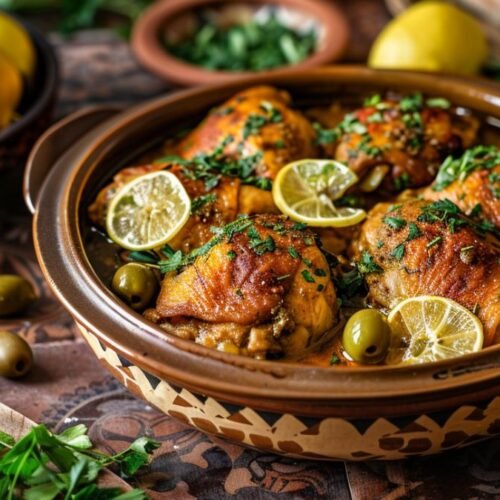
Moroccan Chicken Tagine with Preserved Lemon & Olives
Discover the authentic taste of Morocco with this comforting chicken tagine recipe. Made with tender chicken thighs, preserved lemons, green olives, and traditional spices, it’s a slow-cooked dish that brings warmth and depth of flavor to your table. Perfect for family dinners or special occasions.
Equipment
- 1 Traditional clay tagine or heavy-bottomed pot
- 1 Mixing bowl
- 1 Chef’s knife
- 1 Chopping board
- 1 Wooden spoon
Ingredients
- 5 Pieces Chicken thighs Bone-in, skin-on preferred
- 2 Tbsp Olive oil Extra virgin
- 1 Large Onion Cut into wedges
- 3 Cloves Garlic Finely minced
- 1 Whole Preserved lemon Guartered, seeds removed
- 100 grams green olives Pitted
- 1/2 Bunch Fresh cilantro Chopped
- 1/2 Bunch Fresh parsley Chopped
- 1/2 Teaspoon Ground cumin
- 1 Teaspoon Ground ginger
- 1/2 Teaspoon Paprika Sweet or smoked
- 1/2 Teaspoon Turmeric
- 1/2 Teaspoon Ground black pepper or to taste
- 1/2 Teaspoon Salt or to taste
- 200 ml Water
- 1/2 Whole Lemon
Instructions
- Prepare the Marinade: In a bowl, mix olive oil, ginger, cumin, paprika, turmeric, pepper, salt, garlic, and lemon juice. Coat the chicken thighs and let marinate for at least 1 hour (overnight recommended).
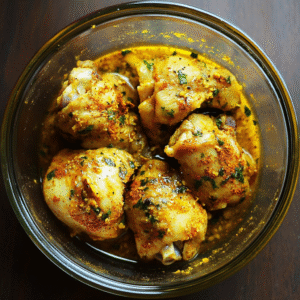
- Sauté the Onions: In your tagine or pot over medium heat, add a bit of oil and sauté chopped onions until translucent.
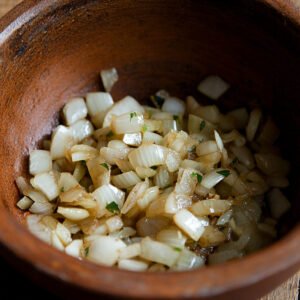
- Add Chicken & Herbs: Place marinated chicken over the onions. Scatter preserved lemon quarters and olives around. Sprinkle with chopped parsley and cilantro.
- Add Water & Simmer: Pour water gently around the tagine edges. Cover and cook on low heat for 1 hour and 15 minutes, until chicken is tender and sauce is reduced.
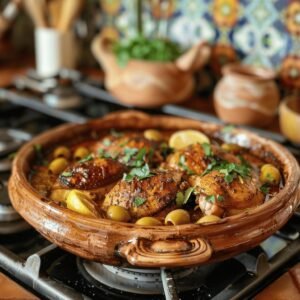
- Serve: In the tagine, garnished with fresh herbs if desired. Enjoy with warm Moroccan bread for dipping, or serve alongside couscous.
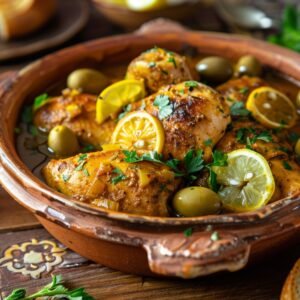
Notes
- Tagine vs. Skillet: While a traditional clay tagine brings authentic slow-cooking benefits, this recipe can also be made in a heavy-bottomed skillet or Dutch oven with a lid.
- Preserved Lemon Substitute: If preserved lemons aren’t available, thin slices of regular lemon can be used. However, the flavor will be milder and slightly more bitter. Increase salt slightly to compensate.
- Chicken Cut: This recipe uses 5 chicken thighs (bone-in, skin-on) for optimal flavor and tenderness. You may substitute with drumsticks or mixed parts, adjusting cooking time slightly.
- Spice Adjustment: The listed spices reflect traditional Moroccan flavor. Feel free to adjust according to preference—more cinnamon for warmth, or chili flakes for heat.
- Olives Tip: Use pitted green olives. Moroccan varieties like Picholine are ideal, but any brined green olive works well.
- Make Ahead: The dish tastes even better the next day as the flavors meld. It can be made up to 24 hours in advance and gently reheated before serving.
- Serving Suggestion: Traditionally served directly from the tagine with Moroccan khobz (flatbread) to scoop up the sauce. For a more complete meal, serve with steamed couscous or rice.
- Storage: Refrigerate leftovers in an airtight container for up to 3 days. Reheat gently on the stove to preserve texture and moisture.
- Freezing: This dish freezes well without the olives. Add fresh olives after thawing and reheating to preserve their texture.
Nutrition
Calories: 430kcalProtein: 28gFat: 30gSaturated Fat: 7gCholesterol: 120mgSodium: 940mgFiber: 2gSugar: 3g
Tried this recipe?Let us know how it was!